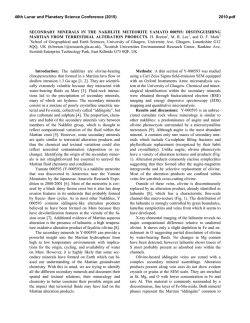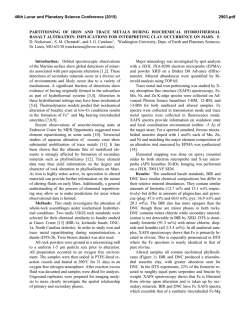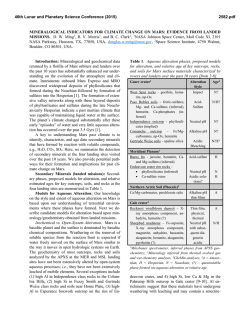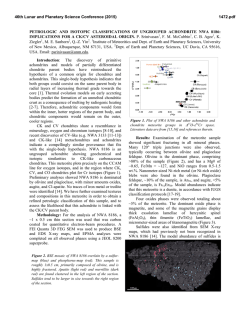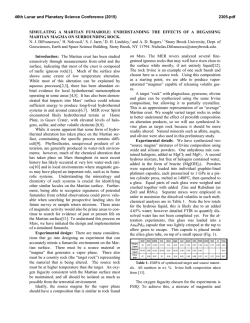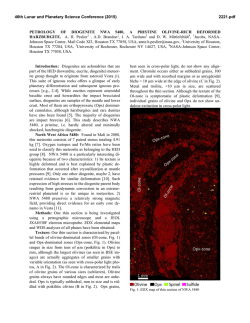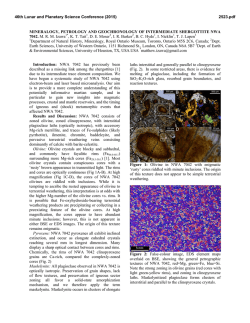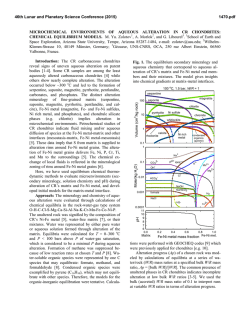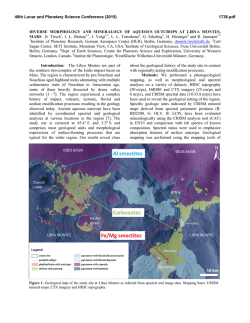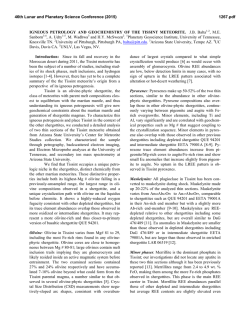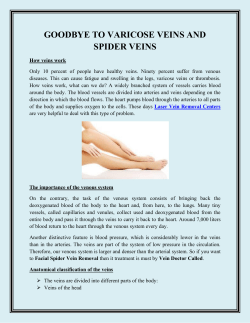
NWA
46th Lunar and Planetary Science Conference (2015) 1929.pdf MULTIPLE AQUEOUS EVENTS IN THE NAKHLITE METEORITE NORTH WEST AFRICA (NWA) 817. H. Breton1, M. R. Lee1, and D. F. Mark2 1School of Geographical and Earth Sciences, University of Glasgow, University Ave, Glasgow, Lanarkshire G12 8QQ, UK ([email protected]), 2Scottish Universities Environmental Research Center, Rankine Ave, Scottish Enterprise Technology Park, East Kilbride G75 0QF, UK Introduction: Geological records suggest the past existence of abundant water flowing freely on Mars’ surface. Most of this aqueous activity appears to have been restricted to early Mars and although aqueous alteration by thin films of water or acid fog may still occur today, evidence suggests that liquid water has not existed at the surface for the last 3 Ga [1]. The Nakhlites, which are 1.3 Ga old Martian meteorites, contain mineralogical proof for the existence of liquid water within the shallow Martian crust duting the Amazonian [2]. To understand the nature of the water-rich fluids and conditions responsible for aqueous alteration on Mars, thorough characterization of chemical and mineralogical changes resulting from aqueous processes is essential. The Nakhlite meteorite North West Africa (NWA) 817 was discovered in the Saharan desert (Morocco) as a single stone of 104g by meteorite hunters in 2000 [4]. In common with most other Nakhlite meteorites, NWA 817 presents mineralogical evidence of interactions with low temperature water-bearing fluids on Mars [5]. Here, we present a petrological and chemical reinvestigation of the alteration products of NWA 817. Our study reveals evidence for multiple fluid infiltrations in Mars subsurface during the Amazonian. Methods: A thin section that was made from a piece of NWA 817 was studied at the University of Glasgow using a Carl Zeiss Sigma field-emission SEM equipped with an Oxford Instruments Aztec microanalysis system. Backscattered electron (BSE) imaging and energy dispersive spectroscopy (EDS) mapping and quantitative analysis techniques were used to identify the alteration products and trace their chemical and mineralogical variations within the rock. Results and discussion: NWA 817 is a clinopyroxenite that also contains olivine phenocrysts and a porous, finely crystalline mesostasis. The mesostasis is composed of skeletal fayalitic olivine and Timagnetite, augite, feldspar, apatite and rare sulfide and silica droplets. In addition, NWA 817 contains preterrestrial alteration products (Fig. 1). They are interpreted to have formed during secondary processing as they occur as irregular and serrated veins cross-cutting olivine phenocrysts (Fig. 1a) [5]. Rarely, veins of alteration products have enclosed symplectites (augitemagnetite integrowths formed by high temperature exsolution) suggesting that veins have enlarged through dissolution-precipitation processes, with the symplectites being less soluble than olivine (Fig. 1b). Alteration products are also present within the mesostasis where they form irregular aggregates rather than well-defined veins of alteration products (Fig. 1c). These masses of alteration products have partially replaced fayalitic olivine suggesting a strong correlation between the chemically weak olivine and secondary mineral precipitation. No other igneous mineral presents evidence of dissolution. Within the host rock, only olivine has been able to provide chemical components to the fluid phase. Fig.1: BSE images of alteration products within olivine (a, b) and mesostasis (c). Alteration veins have enclosed symplectites suggesting vein enlargement through dissolution-precipitation (b). Alteration products (AP) within the mesostasis contain remnants of olivine (c). They probably formed through replacement of fayalite. Three different alteration products are present within olivine grains and the mesostasis. However, we will mainly focus on olivine-hosted veins because spatiotemporal relationships between the three generations are easier to constrain. The first-formed alteration product is located in the center of the veins. It occurs as straight and thin (<< 1 µm wide) “veinlets” of a fibrous, Mg-Si-rich and Fe-poor material (Fig. 2). If we assume that veins formed by dissolution-precipitation, 46th Lunar and Planetary Science Conference (2015) then these “veinlets” probably represent the first alteration product, the crystallization from micro-fissures via which aqueous fluids entered the olivine. These “veinlets” have been partially recrystallized such as it is difficult to define their initial thickness. The second alteration product comprises most of the alteration assemblage (Fig. 2). From SEM observation, it appears largely homogeneous with no obvious polycrystalline texture. This is probably the material that was identified by X-ray diffraction, TEM, and IR and Raman spectroscopy as a hydrous mineral from the smectite family [4]. The elemental composition of this smectitic is dominated by Si and O and to lesser extent Fe with lower concentrations of Mg, although their proportion varies depending on their location. Alteration products of the mesostasis are enriched in Si and Mg and depleted in Fe and Mn relative to those in olivine-hosted veins although they are replacing almost pure fayalite (Fa87.1-94.2). The composition and distribution of elements in the smectitic are consistent with mobilization of dissolved products of olivine before precipitation. The alteration products reflect more the fluid chemistry than the host olivine composition. Fig. 2: X-ray maps of the 1st, 2nd and 3rd generation of alteration products within olivine veins. The red veins are terrestrial calcite. The last-formed alteration product occur along the vein margins (Fig. 2). It consists of a finely crystalline Mn- and Fe-rich mineral, whose true nature still needs to be identified, intercalated with a coarser fibrous Sipoor mineral. This polymineralic assemblage partially cross-cuts and overgrows the smectite, confirming that it crystallized last. The Mn-Fe-rich mineral coarsens towards the olivine vein walls where it tends to form nodules cemented by the fibrous material (Fig. 3). Our NWA 817 sample contains several tens of µmthick fractures filled by calcite, a typical terrestrial contaminant of hot deserts (Fig. 2). No other secondary minerals have been found in surfaces exposed to terres- 1929.pdf trial atmospheric conditions. The terrestrial calcite is physically constrained to fractures and has not been found elsewhere. The calcite has been found in contact with the Martian alteration veins. The terrestrial fluids have locally dissolved away the Mn-Fe-rich mineral phase but do not seem to have significantly exchanged major elements (i.e., Ca) with the Martian alteration products. Fig. 3: BSE image of the polymineralic Mn-Fe-rich alteration products along olivine vein margins Conclusions: Alteration products within the Nakhlite meteorite NWA 817 comprise three generations (Mg-rich, Si-rich, and Mn-Fe-rich) of most probable Martian origin. The distribution and abundance of chemical components in these alteration products is consistent with an origin from partial olivine dissolution during water-limited aqueous alteration. The zoning feature and disequilibrium texture (replacement) between the different alteration products suggest multiple episodes of fluid infiltration. There is no evidence that aqueous fluids have imported chemical elements (except water) into NWA 817. However, volume preservation does imply a transfer of elements out of the meteorite, which is suggestive of flowing rather than static fluids. Variation in the chemical composition (Mg) of the smectite-like material within olivine veins and mesostasis masses also reflects mobilization of elements from host olivine. NWA 817 shows a greater degree of alteration near to surfaces of the meteorite that were exposed to the terrestrial atmosphere (external surfaces and postterrestrial fractures). The sole alteration product associated with exposed surfaces seems to be calcite. No calcite deposition out of the veins has been discovered suggesting that terrestrial contamination has much been restricted to surfaces in contact with the atmospheric elements. References: [1] Bibring J-. P et al. (2006) Science, 312, 400-404. [2] Treiman A. H. (2005) Chemie der Erde, 65, 203-270. [3] Sautter V. et al. (2002) Earth and Planetary Science Letters, 195, 223-238. [4] Gillet Ph. Et al. (2002) Earth and Planetary Science Letters, 203, 431-444
© Copyright 2026
